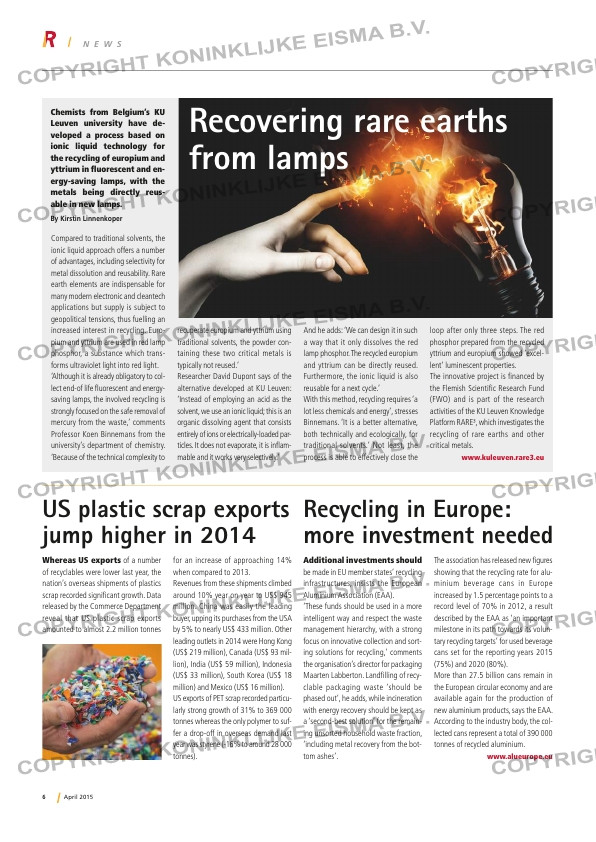Page 6 from: April 2015

6 April 2015
N E W S
Compared to traditional solvents, the
ionic liquid approach offers a number
of advantages, including selectivity for
metal dissolution and reusability. Rare
earth elements are indispensable for
many modern electronic and cleantech
applications but supply is subject to
geopolitical tensions, thus fuelling an
increased interest in recycling. Euro-
pium and yttrium are used in red lamp
phosphor, a substance which trans-
forms ultraviolet light into red light.
‘Although it is already obligatory to col-
lect end-of life fluorescent and energy-
saving lamps, the involved recycling is
strongly focused on the safe removal of
mercury from the waste,’ comments
Professor Koen Binnemans from the
university’s department of chemistry.
‘Because of the technical complexity to
recuperate europium and yttrium using
traditional solvents, the powder con-
taining these two critical metals is
typically not reused.’
Researcher David Dupont says of the
alternative developed at KU Leuven:
‘Instead of employing an acid as the
solvent, we use an ionic liquid; this is an
organic dissolving agent that consists
entirely of ions or electrically-loaded par-
ticles. It does not evaporate, it is inflam-
mable and it works very selectively.’
And he adds: ‘We can design it in such
a way that it only dissolves the red
lamp phosphor. The recycled europium
and yttrium can be directly reused.
Furthermore, the ionic liquid is also
reusable for a next cycle.’
With this method, recycling requires ‘a
lot less chemicals and energy’, stresses
Binnemans. ‘It is a better alternative,
both technically and ecologically, for
traditional solvents.’ Not least, the
process is able to effectively close the
loop after only three steps. The red
phosphor prepared from the recycled
yttrium and europium showed ‘excel-
lent’ luminescent properties.
The innovative project is financed by
the Flemish Scientific Research Fund
(FWO) and is part of the research
activities of the KU Leuven Knowledge
Platform RARE³, which investigates the
recycling of rare earths and other
critical metals.
www.kuleuven.rare3.eu
Chemists from Belgium’s KU
Leuven university have de-
veloped a process based on
ionic liquid technology for
the recycling of europium and
yttrium in fluorescent and en-
ergy-saving lamps, with the
metals being directly reus-
able in new lamps.
By Kirstin Linnenkoper
Additional investments should
be made in EU member states’ recycling
infrastructures, insists the European
Aluminium Association (EAA).
‘These funds should be used in a more
intelligent way and respect the waste
management hierarchy, with a strong
focus on innovative collection and sort-
ing solutions for recycling,’ comments
the organisation’s director for packaging
Maarten Labberton. Landfilling of recy-
clable packaging waste ‘should be
phased out’, he adds, while incineration
with energy recovery should be kept as
a ‘second-best solution’ for the remain-
ing unsorted household waste fraction,
‘including metal recovery from the bot-
tom ashes’.
The association has released new figures
showing that the recycling rate for alu-
minium beverage cans in Europe
increased by 1.5 percentage points to a
record level of 70% in 2012, a result
described by the EAA as ‘an important
milestone in its path towards its volun-
tary recycling targets’ for used beverage
cans set for the reporting years 2015
(75%) and 2020 (80%).
More than 27.5 billion cans remain in
the European circular economy and are
available again for the production of
new aluminium products, says the EAA.
According to the industry body, the col-
lected cans represent a total of 390 000
tonnes of recycled aluminium.
www.alueurope.eu
Recycling in Europe:
more investment needed
Whereas US exports of a number
of recyclables were lower last year, the
nation’s overseas shipments of plastics
scrap recorded significant growth. Data
released by the Commerce Department
reveal that US plastic scrap exports
amounted to almost 2.2 million tonnes
for an increase of approaching 14%
when compared to 2013.
Revenues from these shipments climbed
around 10% year on year to US$ 945
million. China was easily the leading
buyer, upping its purchases from the USA
by 5% to nearly US$ 433 million. Other
leading outlets in 2014 were Hong Kong
(US$ 219 million), Canada (US$ 93 mil-
lion), India (US$ 59 million), Indonesia
(US$ 33 million), South Korea (US$ 18
million) and Mexico (US$ 16 million).
US exports of PET scrap recorded particu-
larly strong growth of 31% to 369 000
tonnes whereas the only polymer to suf-
fer a drop-off in overseas demand last
year was styrene (-16% to around 28 000
tonnes).
US plastic scrap exports
jump higher in 2014
Recovering rare earths
from lamps
RI-3 NEWS.indd 6 30-03-15 10:07



